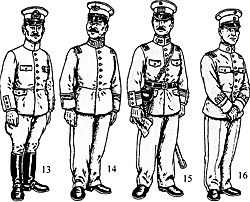 Large version of illustration: (slow download: 71K)
Large version of illustration: (slow download: 71K)
Figure 13: General Alvaro Obregón in campaign dress , 1914. [all figures are from photographs unless otherwise noted] All khaki [or conceivably "lead grey"] cap, tunic and breeches. The tunic has 3-button khaki patches sewn to the outer side of the cuff in imitation of the service uniform, a non-regulation but common variation among officers. Gilded buttons. Black boots, cap peak and chinstrap [officers seem most commonly to have worn black leatherwork, though brown was also worn, or combinations of the two; all pretty much to personal taste] . The only insignia worn is the silver Mexican eagle within a gold wreath [unfortunately not too clear in my sketch] embroidered on a large dark blue patch on the cap front.
Figure 14: Pancho Villa in service/full dress uniform of a General, 1914 Blue-black cap, black peak and chinstrap, the Mexican eagle within a wreath as cap badge [which appears to be of metal in the photograph?], the cap band appears in the photo as a slightly lighter shade, and might conceivably be red. Entirely blue-black tunic, including collar and cuffs, with gilt buttons, gold lace intertwined palm, laurel and olive branch embroidery and "baguette" edging on the collar and cuffs [identical to the pattern used on earlier uniforms]. Black transverse shoulder "straps" embroidered in gold and silver. Blue-black trousers with a red stripe [or conceivably a double stripe, not clear in my photo?]. Black boots.
The 1913-14 dress regulations de not seem to have been very clear on the subject of General's facing colours. there would seem to have been some indication that red facings would be acceptable, but the whole subject was left rather "up in the air". Some Generals during this period do appear to have worn red facings on various parts of the uniform, but the majority seem to have used a plain blue-black uniform with no coloured facings except for trouser stripes [and many didn't even wear those].
Occasionally the gold palm, laurel and olive branch embroidery seems to have been worn circling the cap band, though this would appear to be contrary to regulation. The eagle within a wreath was the only authorised cap device for generals, though it was applied in a variety of forms and sizes; the national cockade was sometimes worn above this device on the cap front.
Figure 15: Captain, 19th Infantry Battalion, Service/duty dress, 1914 [after J. Hefter, Company of Military Historians plate No.191]. Blue-black cap with a rather darkish red band and top piping [in the reprint of this plate in the "Military Uniforms in America series the infantry facing colour is described as "crimson"; in fact "garance" is not quite as dark as crimson, more like a "madder red"], black peak and chinstrap, the 3 vertical bars of his rank on a blue-black patch on the front of the band with the red-white-green national cockade above.
Blue-black tunic with "garance" red collar, cuff flaps, and piping edging the blue-black cuffs, the gilt battalion number is worn on a pointed blue-black patch on the front of the collar, gilt buttons, 3 gold rank stripes circling the cuffs, black shoulder "straps" with a double gold edging and 3 gold bars in the centre. Blue-black trousers with a "garance" red stripe. Black belts, pistol holster and boots, white gloves, nickeled steel sabre scabbard.
While this is probably the most familiar depiction of the officer's service dress of this period, I have a few problems with it, particularly in regard to the blue-black collar patches and the patch backing the rank bars on the cap band. While these items were authorised by the 1919 dress regulations, they rarely appear in photos of the civil war period and should not be taken as typical.
The wearing of rank insignia on the front of the cap band does appear to be according to regulation at this period, though there was so much variation it is difficult to be absolutely certain. A few officers wore their rank insignia in the form of gold or silver laces circling the cap band, following the system used on the cuffs of the service dress tunic.
Figure 16: Major; Unknown Branch of Service, Service/Full Dress uniform, 1915. Entirely blue-black uniform with cap band and top piping, collar, round cuffs and trouser stripe of a lighter shade. A single wide stripe of metallic lace circles the top of the cuff and a single 5-point star adorns the front of the cap band, both indicating his rank. An unclear badge [probably indicating branch of service] on the front of collar. Above the cuffs are 3 vertical Spanish-type "sardinetas" of the same metallic lace; since such devices generally indicated some sort of elite unit, it is conceivable this is an officer of the presidential Guard, in which case his facings would be light blue [though this is purely speculation] .
The Federalist Army 1911-1913
The Constitutional Army 1913-1917
-
Figures 13-16: Gen., Pancho Villa, Capt., Major
Figures 17-20: Officers
Figures 21-23: Infantry
Figures 24-26: Infantry
Back to Table of Contents: Booklet No. 5, Mexican Army 1900-20
Back to El Dorado List of Issues
Back to Master Magazine List
© Copyright 1997 by The South and Central Military Historians Society
This article appears in MagWeb (Magazine Web) on the Internet World Wide Web.
Other military history articles and gaming articles are available at http://www.magweb.com